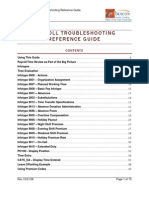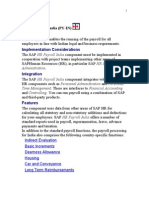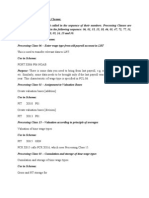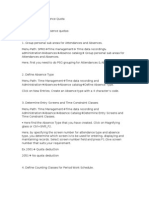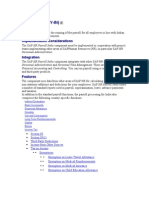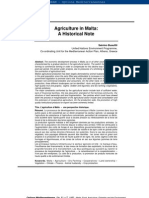Indirect Evaluation (INVAL) and 40ECS Feature: Purpose
Indirect Evaluation (INVAL) and 40ECS Feature: Purpose
Uploaded by
Tejaswi ReddyCopyright:
Available Formats
Indirect Evaluation (INVAL) and 40ECS Feature: Purpose
Indirect Evaluation (INVAL) and 40ECS Feature: Purpose
Uploaded by
Tejaswi ReddyOriginal Description:
Original Title
Copyright
Available Formats
Share this document
Did you find this document useful?
Is this content inappropriate?
Copyright:
Available Formats
Indirect Evaluation (INVAL) and 40ECS Feature: Purpose
Indirect Evaluation (INVAL) and 40ECS Feature: Purpose
Uploaded by
Tejaswi ReddyCopyright:
Available Formats
Indirect Evaluation (INVAL) and 40ECS Feature
Purpose
Indirect Evaluation is a method to calculate the eligible amounts for some of the wage types. INVAL is the Indirect Evaluation Module used to meet the Indian specific business requirements. INVAL calculates the eligible amounts for certain wage types that are defaulted into the Basic Pay Infotype (0008) or entered in the Recur. Payments/Deductions Infotype (0014) and the Additional Payments Infotype (0015). When you populate the Long term reimbursements Infotype (0590), the infotype checks the INVAL amounts for eligibility. The Claims programs also check the INVAL amounts while processing claims. In addition to, or instead of, computing the eligibility as a currency value amount, INVAL can also calculate the eligibility in terms of numbers, if the wage type has been configured accordingly. For example, an employee can be eligible for 50 liters of petrol. When you are populating the Basic Pay Infotype (0008), the wage types get defaulted into the infotype depending on the Pay Scale Grouping for Allowances of the employee. Pay Scale Grouping for Allowances determines the eligible wage types for the employee. For some of these wage types, which get defaulted into the Basic Pay Infotype (0008), the eligible amounts also get defaulted. This happens due to Indirect Evaluation Module INVAL. For Recur. Payments/Deductions Infotype (0014) and Additional Payments Infotype (0015), if you enter an INVAL wage type, the eligible amount will get defaulted into the infotype. This is also due to Indirect Evaluation. In case of Basic Pay Infotype (0008), Recur. Payments/Deductions Infotype (0014) and Additional Payments Infotype (0015), if you overwrite the Indirectly Evaluated amounts, the amounts entered by you are valid. In this case, the I indicator in the Ind. Val. will disappear. Again, if you delete this overwritten amount, the default amount and the I indicator in the Ind. Val. will reappear. The INVAL amount for a default wage type for an employee may change in the middle of the year. In this case, you can check the eligibility amount on a particular date, by entering that date in the start date of the IV field at the bottom of the Basic Pay Infotype (0008). There are four module variants for INVAL: 1. A This calculates the value of the wage type as a fixed amount. 2. B This calculates the amount as a percentage of a base wage type added to a fixed amount. More than one such amount, with same or different percentage of the base wage type, can be calculated for an INVAL wage type. In this case, the amount that will be Indirectly Evaluated will be the sum of all such calculated amounts, added to a fixed amount. For example, for the wage type M230, the different INVAL B amounts are a. 10% of MB10 b. 30% of M220 c. Fixed amount of Rs.1000 In this case, the INVAL amount for the wage type M230 will be the sum of a, b and c. 3. C This calculates the amount as a percentage of a base wage type subject to a maximum limit. More than one such amount, with same or different percentage of the base wage type, can be calculated for an INVALwage type. In this case, the amount that will be Indirectly Evaluated will
be the sum of all such calculated amounts, subject to a maximum limit. For example, for the wage type M230, the different INVAL C amounts are a. 10% of MB10 b. 30% of M220 c. Limit of Rs.5000 In this case, the INVAL amount for the wage type M230 will be the sum of a and b subject to a maximum of c. 4. D This calculates the amount as one or any combination of the following INVAL Module variants based on Basic salary slabs: a. Fixed amount b. Percentage of a base wage type added to a fixed amount c. Percentage of a base wage type subject to a maximum limit In the SAP system, INVAL D can be configured as only INVAL B or C. Once the percentage of the base wage type is calculated, the result is multiplied with a factor. This resultant amount is then added to fixed amount or is compared with a maximum limit. For example, the INVAL module variant for the wage type M210, for an employee who falls in the Basic Salary slab of Rs.10,000 12,000, is INVAL C. The INVAL amounts are: i. ii. iii. iv. 10% of MB10 30% of M220 Multiplication factor of 50% Limit of Rs.7000
In this case, the INVAL amount for M210 for the employee is the sum of i and ii, multiplied by iii and the result is subject to a maximum of iv. If you want to configure the wage type as a fixed amount for a particular slab, the wage type is configured as INVAL B. In this case, the percentage of the base wage type is multiplied with the factor of 0% and then the fixed amount added to the result. For example, the INVAL module variant for the wage type M230, for an employee who falls in the Basic Salary slab of Rs.15,000 25,000, is INVAL B. The INVAL amounts are: i. ii. iii. 100% of MB10 Multiplication factor of 0% Fixed amount of Rs.5000
In this case, the INVAL amount for M230 for the employee is the value of i, multiplied by ii and the result added to iii. In this case, the INVAL amount will be the fixed amount of Rs.5000. For defining INVAL D, instead of using only the Basic salary to be compared with the salary slabs, you can use the user exit EXIT_SAPLHRPADINA1_006, available in the Enhancement HRINRAP5, to define additional wage types to be added to the Basic salary. The sum of all these wage types can then be compared with the salary slabs for the computation of INVAL D. The base wage type in case of INVAL B, C or D may be the Basic salary, the Dearness Allowance or/and any other wage type the employee is eligible for. Only those factors, which affect the compensation of the majority of employees are assigned to Pay Scale Grouping for Allowances. There are some compensation factors that affect selected employees only.
These compensation factors are not considered to define the Pay Scale Grouping for Allowances. These pay parameters are configured through the 40ECS Feature. Example of such parameters are, number of dependents, marital status, years of experience in the organization. Only the wage types that are Indirectly Evaluated can be further calculated using the 40ECS feature. This feature determines the factor which is multiplied with the INVAL amount to arrive at the amount payable to the employee. For an employee, a wage type may be evaluated using INVAL. But the same wage type may be configured in the 40ECS Feature for the employee. In this case, the factor returned by the 40ECS Feature will be multiplied with theINVAL amount and the total will be defaulted into the respective infotypes. For example, an employee is eligible for a Leave Travel Allowance of Rs.24000 according to Indirect Evaluation. But you can configure the 40ECS feature, so that an employee who has children will get 25% extra for each child for a maximum of two children.
Implementation Considerations
If you want Indirect Evaluation for a wage type, you have to define it as a characteristic of the wage type. To do this, go to the IMG under Payroll India: Reimbursements, Allowances and Perks -> Maintain Wage Type Characteristics. You have to maintain each INVAL wage type for a Pay Scale Grouping for Allowances in the IMG for Payroll India: Reimbursements, Allowances and Perks -> Calculate Eligibility for RAPs. If you want the payroll to check the 40ECS Feature to determine the eligible amount for a particular wage type, you must configure the wage type in the IMG under Payroll India: Reimbursements, Allowances and Perks ->Calculate Eligibility for RAPs.
Integration
Defaulting and Indirect Evaluation for the Housing (HRA / CLA / COA) and Conveyance wage types happen only when you populate and save the respective infotypes Housing (HRA / CLA / COA) Infotype (0581) and Car & Conveyance Infotype (0583).
Features
The important pay parameters that can be configured through the 40ECS feature are: Number of children for children education allowance Number of children for children hostel allowance
In case of these parameters, you also have to configure the relevant wage types in the IMG under Payroll India: Reimbursements, Allowances and Perks -> Calculate Eligibility for RAPs. In this view, you must select Check for Ee characteristics in the Elig Check field. Whether a child is eligible for Child Education Allowance or for Child Hostel Allowance, or whether a dependent is eligible for any other allowance, is entered in the Family/Related Person Infotype (0021). The 40ECS feature checks this infotype and accordingly calculates an eligibility amount for each of the allowances for each employee. The other parameters that can be configured through the 40ECS feature are: Country Grouping Company Code Payscale Grouping for Allowances Wage Type Job Gender Key
Marital status key Region (State, Province, County) Personnel Number Start date
Constraints
Indirect Evaluation requires that the base wage type, on which the evaluation of any other wage type depends, should have been evaluated previously. For example, wage types MB10 and M230 are evaluated indirectly and M230 is evaluated as a percentage of MB10. Then, it is required that MB10 be evaluated prior to M230 in the Basic Pay Infotype (0008).
Basic Pay (Infotype 0008)
You can store the employees basic pay in the Basic Pay infotype (0008) . You get an overview of the employees payroll history using the infotype history. The standard system contains the following reference types: Subtype 0: Basic contract Subtype 1: Increase main contract Subtype 2: Comparable domestic pay Subtype 3: Refund of costs in foreign currency Subtype 4: Local weighting allowance
You can process the Basic Pay infotype (0008) on its own or during a personnel action. If you want to create a new data record, enter the reference type on the screen Maintain HR Master Data. The reference type is already set if you carry out a personnel action
Pay scale
The system automatically proposes the Pay Scale Type and the Pay Scale Area. However, you can overwrite these values.
Wage Types
If you want to insert a data record, the system automatically suggests the wage types. There are a few wage types that you can not overwrite or delete. You can enter up to forty wage types. You specify the number of wage types in the LGMST feature. When an employee leaves a company you are not permitted to delimit the Basic Pay infotype (0008). Basic payroll data must remain in the system. This is the only way of ensuring the accuracy of any retroactive accounting runs that need to be performed.
Recurring Payments/Deductions (Infotype 0014)
By specifying a wage type in the Recurring Payments/Deductions infotype (0014), you can enter an amount and/or a value and a unit of measurement that should always be paid or deducted by Payroll. Recurring payments/deductions are wage elements which are paid or deducted in every payroll period. In contrast to additional payments, recurring payments/deductions are paid or deducted within a defined periodicity. In addition, you have the possibility to enter default cost assignment settings for recurring payments/deductions for the application component Controlling (CO). This enables you, for example, to store a different cost center and company code combination than the one in the Organizational Assignment infotype (0001); the additional payments will then be charged to this cost center. Select Edit Maintain cost assignment. The Default Cost Assignment Settings dialog box appears. Enter the relevant data. If any data has already been entered for the cost assignment it will be displayed on the infotype single screen. You can set up further controlling objects in the Customizing for Personnel Administration under Recording Cost Assignment Specifications. The standard system contains, amongst others, the following wage types:
Subtype M110: Vacation bonus Subtype M120: Christmas bonus Subtype M30: Special payment
Recurr. Payments/Deductions Enter the wage type that is to be paid or deducted in the Wage Type field. In conjunction with the Wage type you must process either the Amount field or the Number and Unit fields. The system checks the combination entered. The currency is defaulted according to the company code. This can be overwritten. Date of Payment The wage type should only be paid in certain periods or on certain days; this can be defined either in the fields 1st payment period and Interval in periods, thus defining the interval to the next and all subsequent periods, or in the fields 1st payment date and Interval/Unit, thus defining the interval to the next day and all subsequent days. Enter the payment period without the payroll year. The subsequent payment periods will be determined by adding the intervals.
If the report RPCDTBX0 (Preliminary Data Medium Exchange Program for Separate Payment Run) has created a preliminary document for a wage type transfer, the Transfer field is displayed on the infotype screen. You can not delete the wage type in this case.
You might also like
- HR400Document14 pagesHR400SureshNo ratings yet
- Indian Payroll Help SAPDocument133 pagesIndian Payroll Help SAPPrem Singh100% (1)
- Processing ClassDocument6 pagesProcessing ClassVishalNo ratings yet
- Sap HCM PCRDocument3 pagesSap HCM PCRrajesh07950% (2)
- Canara Bank - Revised Guidelines On Compressed Bio Gas Plants FinanceDocument12 pagesCanara Bank - Revised Guidelines On Compressed Bio Gas Plants Financefreesites485No ratings yet
- HR305 Course NotesDocument60 pagesHR305 Course Notesaesakip100% (2)
- Payroll Troubleshooting Reference GuideDocument75 pagesPayroll Troubleshooting Reference Guidesenthilmask80100% (2)
- SAP HR-Set Up Personnel Action - Configuration StepsDocument16 pagesSAP HR-Set Up Personnel Action - Configuration StepsSomasekharVankadari100% (2)
- SAP HR Stepwise Screen ShotsDocument41 pagesSAP HR Stepwise Screen ShotsVIN_J67% (3)
- Final Project Report On Investment BankingDocument26 pagesFinal Project Report On Investment BankingSophia Ali78% (9)
- Indian Payroll Help-SAPDocument238 pagesIndian Payroll Help-SAPJitendra Kumar60% (5)
- Indirect Valuation - SAP HCMDocument9 pagesIndirect Valuation - SAP HCMkarishma0110100% (2)
- HR Organizational Management ConfigurationDocument54 pagesHR Organizational Management ConfigurationKhagendra SinghNo ratings yet
- PCR and SchemaDocument15 pagesPCR and SchemaBullet Bairagi100% (1)
- Generate Time Wage Types by Configuring Table T510SDocument8 pagesGenerate Time Wage Types by Configuring Table T510SSai Shilpa Teju100% (2)
- SAP Payroll Basics - Part 2: Central Functions in The Payroll Schema - Insight Consulting PartnersDocument2 pagesSAP Payroll Basics - Part 2: Central Functions in The Payroll Schema - Insight Consulting PartnersDionisis Panagopoulos100% (5)
- Retroactive Accounting PDFDocument16 pagesRetroactive Accounting PDFMohamed Shanab100% (3)
- How To Execute Payroll in SAP & in Background Imp 2Document5 pagesHow To Execute Payroll in SAP & in Background Imp 2Manepali TejNo ratings yet
- Personnel Calculation Rule and Schema - An UnderstandingDocument14 pagesPersonnel Calculation Rule and Schema - An UnderstandingBharathk KldNo ratings yet
- Internal Tables For PayrollDocument19 pagesInternal Tables For PayrollJoe CuervoNo ratings yet
- Configuring SAP HR Payroll Settings For Retroactive AccountingDocument1 pageConfiguring SAP HR Payroll Settings For Retroactive Accountingravibabu1620100% (1)
- Understanding Absence QuotasDocument31 pagesUnderstanding Absence QuotasHan Maryani100% (2)
- Personnel ActionsDocument20 pagesPersonnel Actionstauras100% (2)
- Dynamic Actions - Multiple ScenariosDocument7 pagesDynamic Actions - Multiple ScenariosSuresh Kumar100% (1)
- Configuration Steps in Off Cycle PayrollDocument3 pagesConfiguration Steps in Off Cycle Payrollnumerinon100% (2)
- List of PCRs Used in India PayrollDocument5 pagesList of PCRs Used in India PayrolleurofighterNo ratings yet
- Concept of SchemaDocument7 pagesConcept of SchemaBiru Bhai100% (1)
- 0: Valuation Basis /1: Cumulation Wage Type /2: Averages /3,/4,/6: Taxation /5: Retroactive Handling or Net /8: Factoring Wage Types /a,/x Outflow Wage Types /559 Stands For Bank PaymentDocument5 pages0: Valuation Basis /1: Cumulation Wage Type /2: Averages /3,/4,/6: Taxation /5: Retroactive Handling or Net /8: Factoring Wage Types /a,/x Outflow Wage Types /559 Stands For Bank PaymentLokesh Derashri100% (1)
- Understanding HR Schema and PCR With An ExampleDocument7 pagesUnderstanding HR Schema and PCR With An Examplemadaxx2010100% (2)
- Payroll Control Center - Check Implementation GuideDocument31 pagesPayroll Control Center - Check Implementation Guidenikebara100% (5)
- Indian Specific Processing ClassesDocument9 pagesIndian Specific Processing ClassesRakesh RakeeNo ratings yet
- BBP Questionnaire For RSCL - HCMDocument6 pagesBBP Questionnaire For RSCL - HCMnarayanaNo ratings yet
- SAP ERP HCM Wage Types, Pay Structures and Master Data MaintenanceDocument10 pagesSAP ERP HCM Wage Types, Pay Structures and Master Data Maintenanceravibabu1620100% (1)
- SAP ERP HCM Payroll ConfigurationDocument2 pagesSAP ERP HCM Payroll Configurationbushke getahunNo ratings yet
- Organizational Management Training Manual - en V1.0Document28 pagesOrganizational Management Training Manual - en V1.0Aditya DeshpandeNo ratings yet
- Dynamic ActionsDocument5 pagesDynamic ActionsArun Kumar100% (1)
- TM Timemanagementconfiguration 150327190854 Conversion Gate01Document8 pagesTM Timemanagementconfiguration 150327190854 Conversion Gate01Carmen DiacNo ratings yet
- Read 9788120338722 Sap HR India Payroll Technical Reference and Lea PDFDocument1 pageRead 9788120338722 Sap HR India Payroll Technical Reference and Lea PDFUday KiranNo ratings yet
- Income Tax Calculation (SAP Library - Payroll India (PY-IN) )Document6 pagesIncome Tax Calculation (SAP Library - Payroll India (PY-IN) )Pradeep KumarNo ratings yet
- Sap HR - Question AnswerDocument35 pagesSap HR - Question Answersumitvfx87100% (3)
- Instructor Guide40 - HR311 - Time Eval Without Clock TimesDocument37 pagesInstructor Guide40 - HR311 - Time Eval Without Clock TimesRogério Andrade Dos Santos100% (1)
- SAP HR Common Error MessagesDocument16 pagesSAP HR Common Error MessagesSaraswathi Nimmagadda100% (2)
- Understanding Functions in Payroll Schemas (Specific Eg, WPBP) - SAP BlogsDocument22 pagesUnderstanding Functions in Payroll Schemas (Specific Eg, WPBP) - SAP Blogsnoidsonly100% (4)
- SAP HR - HCM - Personnel AdministrationDocument9 pagesSAP HR - HCM - Personnel AdministrationMrinal Kanti DasNo ratings yet
- SAP HCM PA Class - Dynamic Actions in Detail, 2 Dyn Act ExamplesDocument4 pagesSAP HCM PA Class - Dynamic Actions in Detail, 2 Dyn Act ExamplesmohanNo ratings yet
- Absence Quota Generation StepsDocument27 pagesAbsence Quota Generation StepsAshok Kancharla100% (2)
- SAP HCM - Add Infotypes To PA30Document4 pagesSAP HCM - Add Infotypes To PA30sainath89100% (1)
- Indirect Evaluation (INVAL) and 40ECS Feature: PurposeDocument4 pagesIndirect Evaluation (INVAL) and 40ECS Feature: Purposeraju rajNo ratings yet
- Payroll India DocumentationDocument98 pagesPayroll India DocumentationjalajaeNo ratings yet
- SAP INPY - Documentation Part 1Document80 pagesSAP INPY - Documentation Part 1AmithRaghavNo ratings yet
- India Payroll View Sap Doc Download Indian Payroll Help SapDocument134 pagesIndia Payroll View Sap Doc Download Indian Payroll Help SapPrakash100% (1)
- Purpose and Use of Indirect Evaluation in SAP HCMDocument5 pagesPurpose and Use of Indirect Evaluation in SAP HCMNikhil KushwahaNo ratings yet
- SAP HCM Study Material - PayrollDocument8 pagesSAP HCM Study Material - PayrollAditya_Vickram_540No ratings yet
- Wage Type Screen ShotsDocument33 pagesWage Type Screen ShotsBhoj RawalNo ratings yet
- TCS & Infy SapDocument13 pagesTCS & Infy SapVemula PraveenNo ratings yet
- SAP Income TaxDocument5 pagesSAP Income TaxBullet BairagiNo ratings yet
- Example Relating To PostingsDocument5 pagesExample Relating To Postingsravibabu1620No ratings yet
- Indirect Valuation of Wage TypesDocument7 pagesIndirect Valuation of Wage TypesNikhil KushwahaNo ratings yet
- SAP-HR Mydoc 2Document15 pagesSAP-HR Mydoc 2Rajiv KumarNo ratings yet
- Saprate of Pay & Valuation BasesDocument24 pagesSaprate of Pay & Valuation BasesrameshjakkulaNo ratings yet
- 2022 All Solved Past PapersDocument209 pages2022 All Solved Past PapersareehaanaaveedNo ratings yet
- Exercises Chapters 1, 2, 5, 6, 7 Term 3 2018 2019Document14 pagesExercises Chapters 1, 2, 5, 6, 7 Term 3 2018 2019Krizelle Anne Taguinod100% (1)
- Agatha ReportDocument12 pagesAgatha ReportDianne ChanNo ratings yet
- Required: Using The Data Above, Complete The Following Statements and Schedules For The First QuarterDocument6 pagesRequired: Using The Data Above, Complete The Following Statements and Schedules For The First QuarterNomunzul GanpurevNo ratings yet
- LEGO Group A Strategic and Valuation AnalysisDocument85 pagesLEGO Group A Strategic and Valuation AnalysisRudmila Ahmed50% (2)
- Bartlett Company FR ExampleDocument6 pagesBartlett Company FR ExampleSarah Nabilla Yasmin RizaNo ratings yet
- Case Study - JVG ScandalDocument2 pagesCase Study - JVG ScandalAdvay SinghNo ratings yet
- Bhavik Radia 37 Lewins Rail Ave South Morang Vic 3752 AustraliaDocument3 pagesBhavik Radia 37 Lewins Rail Ave South Morang Vic 3752 Australiabhavikradia13No ratings yet
- Insurance LawDocument52 pagesInsurance LawSenelwa Anaya100% (5)
- NAS 40 Investment PropertyDocument16 pagesNAS 40 Investment PropertyKBtricksNo ratings yet
- Quota Impacts and DisadvantagesDocument2 pagesQuota Impacts and DisadvantagesDarshika Singh - KumarNo ratings yet
- Nursery Care Corporation Vs AcevedoDocument1 pageNursery Care Corporation Vs AcevedoLouana AbadaNo ratings yet
- CIWM Syllabus - NewDocument11 pagesCIWM Syllabus - NewG Rakesh ChowdaryNo ratings yet
- Constitution For A Private Company Limited by Shares. Companies Act 2019 (Act 992)Document13 pagesConstitution For A Private Company Limited by Shares. Companies Act 2019 (Act 992)sharonreich114No ratings yet
- Notes On Commodity and Derivatives Market 2023 24Document105 pagesNotes On Commodity and Derivatives Market 2023 24kriti jajooNo ratings yet
- Ta TCNH 1Document7 pagesTa TCNH 1Nguyen Linh ChiNo ratings yet
- Rizwan Ul Hassan O and A Level Accounting 0322-7222240Document28 pagesRizwan Ul Hassan O and A Level Accounting 0322-7222240rizwan ul hassanNo ratings yet
- Chap 001Document6 pagesChap 001Vicky CamiNo ratings yet
- Operation MGMT - Group & Individual Assignment-FinalDocument44 pagesOperation MGMT - Group & Individual Assignment-FinalainNo ratings yet
- Chapter 3 - ReceivablesDocument50 pagesChapter 3 - ReceivablesTaehyung KimNo ratings yet
- Subject - Financial Services: Credit RatingDocument25 pagesSubject - Financial Services: Credit RatingDileep SinghNo ratings yet
- Agriculture in Malta - A Historical NoteDocument18 pagesAgriculture in Malta - A Historical NoteKayliekayl Nha RuzkhaNo ratings yet
- Exercise Argument and Non ArgumentDocument2 pagesExercise Argument and Non ArgumentStephen BuenoNo ratings yet
- Fundamentals of AccountingDocument3 pagesFundamentals of AccountingJelo sunidoNo ratings yet
- The Macedonian Digest November 2011Document47 pagesThe Macedonian Digest November 2011admin6920% (1)
- Advanced Corporate AccountingDocument242 pagesAdvanced Corporate AccountingMuskan GuptaNo ratings yet
- Case Background: Kaustav Dey B18088Document9 pagesCase Background: Kaustav Dey B18088Kaustav DeyNo ratings yet
- Pci BbsydpDocument29 pagesPci BbsydpArslan ZafarNo ratings yet







